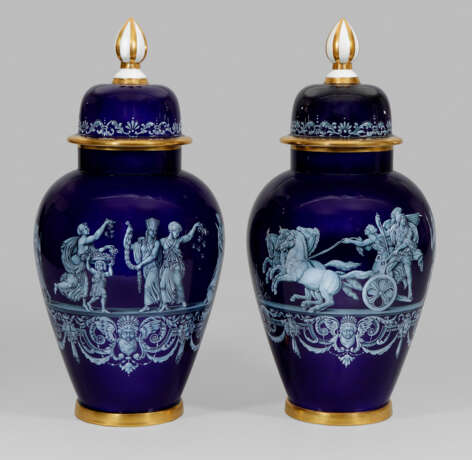ID 855877
Lot 964 | Seltenes Paar prächtiger monumentaler Vasen
Estimate value
€ 95 000 – 190 000
"Triumphzug Alexander des Großen nach Babylon"
Über abgesetztem, goldstaffiertem Stand balusterförmiger Korpus mit gerundeter Schulter und kurzem, zylindrischem Hals. Haubenartiger, überkragender Deckel mit großem, spitzem Knauf. Kobaltblauer Fond. Auf der Wandung Bilderfolge aus verschiedenen, antikisierenden Figurenszenen auf breitem, renaissanceartig stilisiertem Ornamentsockel aus Laub- und Bandelwerk mit Maskaronköpfen, Blumenbuketts und Tuchgehänge, vorzugsweise aus dem Zyklus "Einzug Alexanders des Großen nach Babylon" nach Vorbild des Marmorfrieses von Bertel Thorvaldsen im Schloss Christiansborg in Kopenhagen sowie Zeichnungen und Stiche von Johann Friedrich Overbeck bzw. Samuel Amsler. Umlaufend bildliche Szenen von drei jungen, tanzenden Perserinnen in Begleitung eines Knaben mit blumengefülltem Korb beim Streuen von Blüten zu Ehren von Alexander dem Großen bzw. des babylonischen Feldherrn Bagophanes, der für Alexander einen silbernen Altar mit Räucherschalen am Wegesrand errichten ließ. Verschiedene Begleitszenen eines Paares, wohl Alexander und Roxane, vor der Statue eines griechischen Gelehrten stehend bzw. eines Soldaten in Begleitung einer Frau und eines Mädchens. Auf dem Gegenstück der auf sein Heer zurückblickende, siegreiche Alexander der Große mit Speer in einem von Nike geführten Triumphwagen mit Vierergespann bzw. zwei Soldaten, das Pferd Alexanders Bucephalos bändigend. Weitere Szenen von griechischen Soldaten aus dem Gefolge Alexander des Großen, darunter zwei mit Speer, Schwert und Schild, eine weitere mit einem mit Pfeilen und Bogen bewaffneten Held mit Löwenfell als Kopfbedeckung sowie Darstellung der Statue von Athena vom Typus Vescovali mit verschiedenen, im Vordergrund liegenden Kriegsinstrumenten. Der Deckel umzogen von stilisierter Bordüre aus Akanthus- und Palmblättern. Feine, reliefartige, in Weiß aufgetragene Emailmalerei. Reiche Goldstaffage. Schwertermarke. H. 68 cm.
Äußerst gekonnte, vor kobaltblauem Grund effektvoll plastisch hervortretende Emailmalerei. In Anlehnung an Sèvres und Royal Worcester-Porzellane wurde diese Technik im Stil der Limosiner Maleremail-Arbeiten erstmals 1865 in Meissen ausgeführt und 1867 auf der Weltausstellung in Paris präsentiert. Diese zeigte szenische Darstellungen des Einzuges Alexanders des Großen in Babylon nach Vorlage von Bertel Thorvaldsen (1770 - 1844). Thorvaldsen fertigte den Triumphzug erstmals für Napoleon Bonaparte, danach im Jahre 1829 für Schloss Christiansborg in Kopenhagen, von denen Samuel Amsler Kupferstiche auf Grundlage der Zeichnungen von Friedrich Overbeck anfertigte. Amslers Kupferstiche, die zudem in Hermann Lückes "Der Einzug Alexander des Grossen in Babylon: Marmorfries von B. Thorwaldsen" erschienen sind, boten die Motivgrundlage für die Darstellungen auf der Meissener Weltausstellungsvase wie auch auf diesen Vasen, wobei die Motive hier in größerem Maßstab wiedergegeben sind.
Vgl. Jedding, Meißener Porzellan, Farbtaf. I und S. 86f., Berling, S. 91; Siemen, Nr. 42, S. 368, 377; Klassisches Meissen, S. 103; Thorvaldsen-Museum, Kopenhagen, Inv.-Nr. E 35,0; 10, 11, 14, 15.
A rare splendid pair of monumental lidded porcelain vases with depictions of "Alexander the Great‘s entry into Babylon" after a marble frieze by Bertel Thorvaldsen, drawings by F. Overbeck and engravings by Samuel Amsler painted in white enamel in Limoges style on cobalt-blue ground. Crossed swords mark.
Meissen. Um 1924 - 1934.
| Address of auction |
Kunstauktionshaus Schloss Ahlden GmbH Große Str. 1 29691 Ahlden(Aller) Germany | ||||||||||||||
|---|---|---|---|---|---|---|---|---|---|---|---|---|---|---|---|
| Preview |
| ||||||||||||||
| Phone | +49 5164 80100 | ||||||||||||||
| Buyer Premium | 25.0 | ||||||||||||||
| Conditions of purchase | Conditions of purchase | ||||||||||||||
| Business hours | Business hours
|




